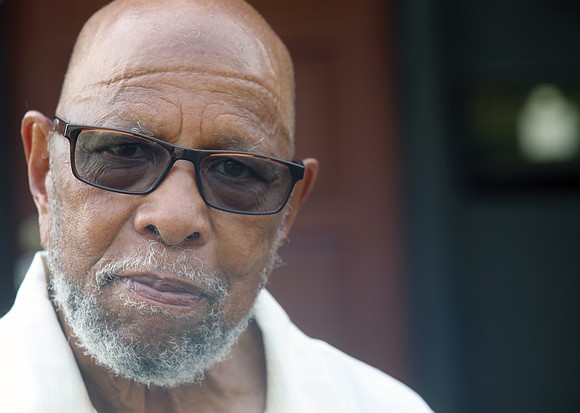Former city councilman pushing African-American perspective missing in Lee statue lawsuit
Jeremy M. Lazarus | 8/27/2020, 6 p.m.

New drama is about to be injected into the already charged legal fight over removing the last and largest offensive Confederate statue from Monument Avenue — the one to slavery’s top military defender, Gen. Robert E. Lee.
Sa’ad El-Amin, a former Richmond City Councilman who has long been outspoken about the need to remove the white supremacist Confederate statues that have dominated the Richmond landscape for more than a century, is preparing to enter the fray.
The former attorney who led City Council’s creation of the Slave Trail Commission to recognize the enslaved and unsuccessfully fought the placement of a mural of Gen. Lee on the city’s floodwall, said he will file on Thursday a motion to intervene and join Gov. Ralph S. Northam as a defendant with the Richmond Circuit Court.
To Mr. El-Amin, the case is crying out for an African-American presence to push the argument about the “pain and anguish” the statue has caused.
“At this point in the proceedings, people of African descent have no voice, no participation, nor any direct involvement in this litigation because the parties, the lawyers and the court are white,” he said. “This is no different than when the decisions were made in 1890 to erect and install the statue.
“As the governor put it, it was wrong then, and it is definitely wrong now,” he said.
Mr. El-Amin’s move to become part of the case to remove a state-owned statue “that has intentionally inflicted pain” on Black people follows Richmond Circuit Court Judge W. Reilly Marchant’s refusal to lift his restraining order barring Gov. Northam from taking down the statue until a full hearing is held on Monday, Oct. 19.
The injunction barring the Lee statue’s removal was sought in a lawsuit by nearby property owners seeking to prevent the statue’s removal.
In his ruling Tuesday, Judge Marchant rejected the argument from state Solicitor General Toby J. Heytens that Virginia has changed in the 130 years since the Lee Monument Association donated the land and monument to the state in exchange for a promise that the state would protect it forever.
Instead, Judge Marchant found that an 1889 General Assembly resolution encouraging acceptance of the monument remains the state’s public policy and that there continues to be a legitimate restrictive covenant in place to protect the statue that the state must abide by, and that Allen Avenue property owners, as suc- cessors to those who gave the land, have a right to enforce.
Mr. Heytens, in his legal brief seeking dismissal of the property owners’ case and the injuction, argued that the viewpoint that “Lee was a heroic figure to be celebrated and the failure of his cause a tragedy to be mourned” has evaporated.
“The statue has become,” he wrote, “an ever-more-painful wound and a focus of the anger and frustration felt by many who continue to suffer the effects of the disgraceful institution (of slavery) the Confederacy sought to protect.”
Noting that a government-owned monument on government- owned property represents “core government speech,” Mr. Heytens wrote that individual Virginians should not and cannot be allowed to “force the Commonwealth of 2020 to continue to broadcast a message with which it disagrees and does not wish to be associated.”
Based on Virginia Supreme Court precedent, Mr. Heytens argued, the 180-degree change in public policy would void any restrictive covenant of the type the plaintiffs described if it existed.
But Judge Marchant noted that he did not have to take judicial notice that any change had occurred sufficient to eliminate the covenant until the October hearing when the state could put on evidence to support the claim.
Mr. El-Amin noted that Judge Marchant, who would have to permit him to intervene in the case, never mentioned the interests of other people, including those of African descent, in his two opinions imposing and continuing the injunction.
Mr. El-Amin believes that the governor’s statements regarding the pain the statue inflicts on African-Americans represent government policy and open the door for him to get into the case.
Gov. Northam “gave us a benefit in acknowledging as a physician the hurt that the statue causes,” Mr. El-Amin said. That creates constitutional issues linked to the 14th Amendment involving equal protection and discrimination on the basis of race, he said.
“I am a third-party beneficiary of the governor’s edict and executive order requiring the removal of the Robert E. Lee statue,” he said, “and I need to be included. The judge should not be able to ignore our interest.”
Mr. El-Amin said that his motion to intervene also would statue has caused.
“At this point in the proceedings, people of African descent have no voice, no participation, nor any direct involvement in this litigation because the parties, the lawyers and the court are white,” he said. “This is no different than when the decisions were made in 1890 to erect and install the statue.
“As the governor put it, it was wrong then, and it is definitely wrong now,” he said.
Mr. El-Amin’s move to become part of the case to remove a state-owned statue “that has intentionally inflicted pain” on Black people follows Richmond Circuit Court Judge W. Reilly Marchant’s refusal to lift his restraining order barring Gov. Northam from taking down the statue until a full hearing is held on Monday, Oct. 19.
The injunction barring the Lee statue’s removal was sought in a lawsuit by nearby property owners seeking to prevent the statue’s removal.
In his ruling Tuesday, Judge Marchant rejected the argument from state Solicitor General Toby J. Heytens that Virginia has changed in the 130 years since the Lee Monument Association donated the land and monument to the state in exchange for a promise that the state would protect it forever.
Instead, Judge Marchant found that an 1889 General Assembly resolution encouraging acceptance of the monument remains the state’s public policy and that there continues to be a legitimate restrictive covenant in place to protect the statue that the state must abide by, and that Allen Avenue property owners, as successors to those who gave the land, have a right to enforce.
Mr. Heytens, in his legal brief seeking dismissal of the property owners’ case and the injuction, argued that the viewpoint that “Lee was a heroic figure to be celebrated and the failure of his cause a tragedy to be mourned” has evaporated.
“The statue has become,” he wrote, “an ever-more-painful wound and a focus of the anger and frustration felt by many who continue to suffer the effects of the disgraceful institution (of slavery) the Confederacy sought to protect.”
Noting that a government-owned monument on government-owned property represents “core government speech,” Mr. Heytens wrote that individual Virginians should not and cannot be allowed to “force the Commonwealth of 2020 to continue to broadcast a message with which it disagrees and does not wish to be associated.”
Based on Virginia Supreme Court precedent, Mr. Heytens argued, the 180-degree change in public policy would void any restrictive covenant of the type the plaintiffs described if it existed.
But Judge Marchant noted that he did not have to take judicial notice that any change had occurred sufficient to eliminate the covenant until the October hearing when the state could put on evidence to support the claim.
Mr. El-Amin noted that Judge Marchant, who would have to permit him to intervene in the case, never mentioned the interests of other people, including those of African descent, in his two opinions imposing and continuing the injunction.
Mr. El-Amin believes that the governor’s statements regarding the pain the statue inflicts on African-Americans represent government policy and open the door for him to get into the case.
Gov. Northam “gave us a benefit in acknowledging as a physician the hurt that the statue causes,” Mr. El-Amin said. That creates constitutional issues linked to the 14th Amendment involving equal protection and discrimination on the basis of race, he said.
“I am a third-party beneficiary of the governor’s edict and executive order requiring the removal of the Robert E. Lee statue,” he said, “and I need to be included. The judge should not be able to ignore our interest.”
Mr. El-Amin said that his motion to intervene also would might not want to offend.
Mr. El-Amin said he also plans to tell the court that the notion that Gen. Lee deserves to be recognized is built on a false image of him as a “man of great personal virtue.”
The historical reality, Mr. El-Amin said, is that Gen. Lee, when he took over management of the estate of his late father-in-law, George W.P. Custis, in Northern Virginia, worked the 189 slaves mercilessly and unsuccessfully fought to overturn a provision in Mr. Custis’ will freeing those slaves five years after his death.
“He has a sordid history in dealing with people of African descent,” Mr. El-Amin said. Mr. El-Amin said he hopes his effort will arouse others.
“This litigation mirrors and emphasizes the point that Gov. Northam made June 4 when he stated, ‘The legacy of racism ... continues as part of a system that touches every person and every aspect of our lives whether we know it or not. So, it’s time to acknowledge the reality of institutional racism.’
“It’s time to get rid of that statue,” Mr. El-Amin said.







